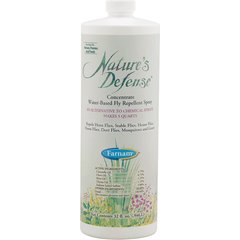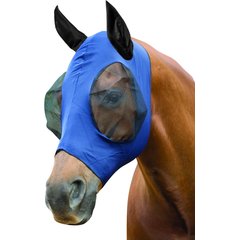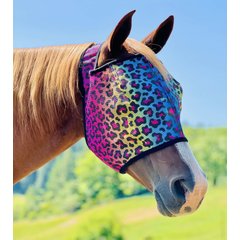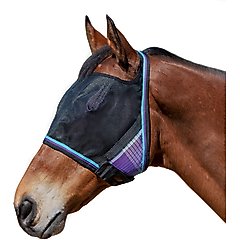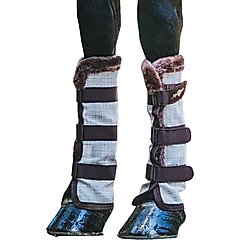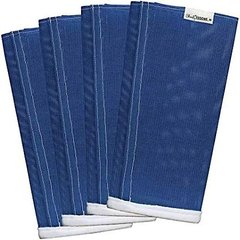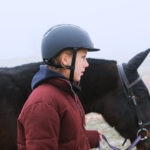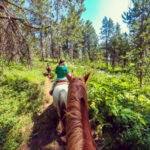Shoo, Fly! Keep Pests Away With Horse Fly Masks and Boots
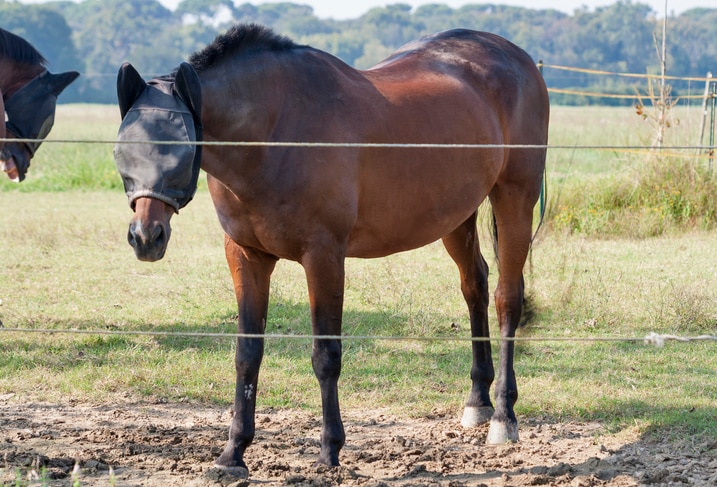
Photo by Panama7/iStock / Getty Images Plus via Getty Images
“Why is that horse blindfolded?” It’s a question virtually every horse owner has been asked—and politely held back a chuckle long enough to explain that the “blindfold” is actually a fly mask for horses. And the matching “tall socks” the horse is wearing are horse fly boots, another equine summer essential.
It’s always important to keep horses as protected as possible when it comes to flies, according to their level of fly vulnerability.
What Are Horse Fly Masks and Boots?
Flies feed on horses’ tears, which horses naturally produce to help flush away any dust or debris. Fly feeding causes eye irritation in a horse, and flies will also bite a horse’s thin-skinned legs and ears to drink their blood.
All those fly bites aren’t just itchy; they’re dangerous—potentially transmitting everything from viruses to a nasty bacterium that creates internal abscesses.
Horse fly masks and boots are designed to keep flies off horses’ faces and legs. Both are typically made of durable mesh or netting. That way horses can easily see out, but flies can’t get in.
When used as part of a comprehensive fly management program, fly masks and fly boots can help interrupt the fly life cycle, reducing their population over time.
Does My Horse Need a Fly Mask or Fly Boots?
Deciding whether your horse should wear a fly mask and/or fly boots starts with assessing how flies are (or aren’t) affecting your horse.
- Horses who have the insides of their ears clipped during fly season will need a fly mask with ears.
- Horses who tend to get aural plaques, which are caused by viruses transmitted by flies, will also need a fly mask.
- Any horse who tends to have conjunctivitis or other eye problems should wear a UV-blocking fly mask during the day.
- Horses with darker coat colors, such as brown or black, are more attractive to flies because those colors can be seen easier.
- If you see fly bites on your horse’s legs or if you see your horse frequently stomping to get rid of flies, invest in a set of horse fly boots.
- All horses living in a region known for habronema (summer sores) should wear fly protection. An ounce of prevention is worth a pound of cure when it comes to this painful parasite!
Some horses don’t like to wear fly masks or boots. In this case, they may resort to more natural alternatives, like rolling, and horse owners may opt to use fly spray instead of masks and boots.
Recommended Products
The Best Horse Fly Masks and Horse Fly Boots
Equine fly masks and fly boots for horses come in just about every conceivable color and pattern. Many technical features are available, from UV protection to performance fabrics. Here are some great options to try:
Recommended Fly Masks
- Shires Fine Mesh Horse Fly Mask with Ears: Fine mesh fly masks keep out mosquitoes and biting blackflies in addition to more typical horseflies. And those nasty little no-see-ums especially love biting ears, so your horse will appreciate the ear protection!
- Weatherbeeta Stretch Bug Eye Fly Mask: Some equine Houdinis seem to delight in destroying their fly masks. A Lycra fly mask like this one, with mesh eyes and ears, will stay on longer than Velcro styles.
- Star Point Horsemanship Fly Mask: If you love dressing your horse in loud patterns that match their personality, Star Point offers a rainbow, cheetah-print fly mask.
- Kensington UViator CatchMask: This 90% UV-protective fly mask is ideal for horses who experience sunburn or eye irritation from UV rays. It also has a special closure allowing the mask to act as a halter.
Recommended Products
Recommended Fly Boots
- Kensington Protective Horse Fly Boots: Horse fly boots with 73% UV protection is a plus for horses with pink-skinned legs, which can get sunburned, especially through a short, fine summer coat.
- Shoofly Leggins: These popular horse fly boots feature an extra-breathable design. They also come in bright orange, a high-visibility plus for horses who live near busy roads or in areas where hunters may be present.
Recommended Products
How Should a Fly Mask Fit a Horse?
Different styles of horse fly masks fit differently, so it’s important to read the manufacturer’s fitting instructions carefully.
Here are some tips for fitting a horse for a fly mask:
- As a general rule of thumb, mesh fly masks fastened under the jowl with Velcro should fit moderately snugly, with one to two fingers of room between mask and jaw.
- Lycra pull-on fly masks have lots of stretch and no adjustability. So all you need to choose is the size. If the mask stays on without twisting, you’ve got the right size.
- If you’re planning to ride your horse with a fly mask on, purchase a mask designed to fit over a bridle, such as the Kensington CatchMask. Horses with headshaking syndrome are often much more comfortable ridden in a mask.
- Horses can wear fly masks over their halters for grooming and handling. It’s safest not to turn horses out in their halters, with or without a fly mask.
Recommended Product
Some horses are initially frightened of fly masks. That makes sense! Horses’ faces are among the most sensitive parts of their bodies.
If your horse resists fly mask application, use positive reinforcement—either treats or scratches will do—to reward any movement toward the mask, even just the flick of an ear. A session or two is usually enough to convince a horse that fly masks are fun, not scary.
FAQs About Fly Masks and Boots for Horses
How long can you leave a fly mask on a horse?
Horses can wear fly masks around the clock, but it’s important to remove the mask at least once a day to remove any dirt and debris on the inside and check for injuries.
Should a horse wear a fly mask in the rain?
Most fly masks can be safely worn in all weather, but flies usually lay low when it’s raining, so a fly mask isn’t really needed in the rain.
Can horses sleep with fly masks on?
Horses sleep quite soundly in their fly masks, as you’ll notice from the mud stains that appear on one side of your horse’s brand-new fly mask after their first night wearing it!
This content was medically reviewed by Kaela Schraer, DVM.

